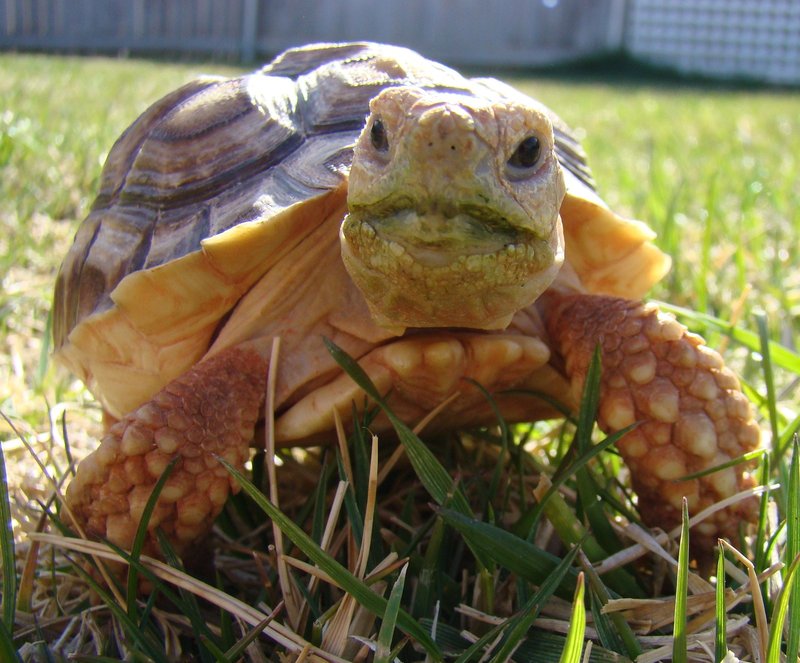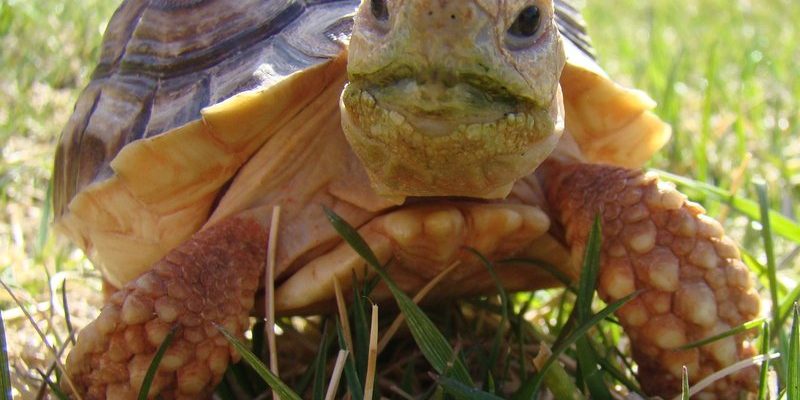
So, how do you actually identify a Sulcata tortoise? It’s not just about recognizing a big shell. In this article, I’ll walk you through what these tortoises look like, their unique traits, and some interesting behaviors. If you’re thinking about getting one or just want to know more about these incredible creatures, you’re in the right place!
Physical Characteristics of the Sulcata Tortoise
One of the first things you’ll notice about a Sulcata tortoise is its impressive size. On average, they can weigh anywhere from 80 to 110 pounds when fully grown! Yes, you read that right. This makes them one of the largest tortoise species. Their shell, or carapace, is another standout feature. It’s typically a tan to light brown color and can be quite domed.
You might be wondering about those beautiful patterns on their shells. Unlike some tortoises that have more subdued shells, the Sulcata has prominent scutes—the individual plates on the shell. These scutes often have a unique, radiant appearance that can make even the most indifferent observer stop and stare. Plus, as they age, the scutes develop a more pronounced texture, giving them a rugged, veteran look.
Another point to note is their limbs. Sulcata tortoises have thick, sturdy legs that allow them to dig and burrow effectively. If you see one pushing itself through the soil or grass, you’ll understand just how strong they are. Their feet are also adapted for digging, equipped with a rough surface that helps them grip the ground.
Behavior and Personality Traits
Sulcata tortoises are not just about looks; they have personalities to match! They’re known for being quite friendly and curious. Often, they will come up to you, especially if they think you might have food in hand. Honestly, who wouldn’t be curious about a big snack?
These tortoises are also quite social among their own kind, though they need ample space if you’re considering more than one. Imagine a party where everyone has their own zone—the same applies here. They enjoy basking in the sun but also appreciate some quiet spots to retreat to when they need a break.
While they may not be the fastest creatures, their lumbering movements can be quite amusing. Watching a Sulcata take its time exploring a new patch of grass can almost be therapeutic. You might find that you’ve spent a whole afternoon just enjoying their antics!
Shell Structure and Coloration
The structure of a Sulcata tortoise’s shell is incredibly important for its health and well-being. Here’s the thing: a healthy shell should look smooth and well-maintained. If you notice any signs of abnormal growth or discoloration, that could be a red flag.
The coloration of the shell often varies based on their habitat. In the wild, their shells might have more muted tones that help them blend into their surroundings, while pet Sulcatas often exhibit richer colors due to diet and environment. A well-fed Sulcata shows vibrant colors that gleam in the sun, while a malnourished one might look dull and faded. Keeping an eye on their diet is essential, as it directly affects their overall health and shell condition.
Understanding these factors can help you identify not just if it’s a Sulcata tortoise, but also whether it’s healthy and thriving. If you’re ever in doubt, consulting a vet specializing in reptiles is always a good idea. They can give you insights tailored specifically to your tortoise.
Habitat and Environment Needs
If you’re thinking of keeping a Sulcata tortoise, knowing about their natural habitat is crucial. In the wild, they would roam through grasslands, digging burrows for shelter and staying out of extreme temperatures. Mimicking this environment is key for their happiness and health.
A large outdoor space with plenty of grass and safe areas to dig will keep your Sulcata content. Think of it as creating a mini savanna in your backyard! If you’re in a colder climate, you’ll need a heated indoor habitat where they can stay warm and comfortable during the winter months. This setup is not just for show; it’s about replicating their natural instinct to thrive in warm, dry environments.
Humidity also plays a role; while they prefer dry conditions, they still benefit from occasional baths to help with hydration. It’s all about balancing their needs to keep them happy and healthy.
Diet and Nutrition
Feeding a Sulcata tortoise is an essential part of ensuring they stay healthy. They mainly enjoy a herbivorous diet consisting of grasses, hay, and some leafy greens. You might be wondering, “Can they eat fruits or veggies?” While they can nibble on some, like the occasional piece of banana or squash, it’s best to keep these as treats. Too much sugar can be harmful!
What’s more, providing a variety of grass types can help mimic their natural feeding behavior. Some favorite options include timothy hay and dandelion greens. Just think of it like serving a buffet—variety ensures they get all the nutrients they need. Also, make sure they have access to fresh water at all times. Although they get some moisture from their food, a source of water is vital, especially in warmer months.
Here’s a tip: avoid feeding them high-protein foods like dog food or meat. Their digestive systems aren’t set up to handle that, leading to health problems down the road. Stick to what they know and love!
Common Health Issues
Like any pet, Sulcata tortoises can face health issues if not cared for properly. One common problem is shell rot, which occurs when the shell becomes soft and mushy, often due to excess moisture. You can usually prevent this by ensuring they have a dry living environment and proper ventilation.
Another concern is respiratory infections. These can happen if your tortoise is kept in damp or cold conditions. If you notice any signs of wheezing or mucus, it’s time for a trip to the vet. Being proactive with veterinary check-ups can help catch these issues early—think of it like a yearly oil change for your car!
Lastly, you may encounter metabolic bone disease if they don’t get enough calcium or UV light. This can lead to weak shells and bones. To avoid this, ensure they have proper exposure to UVB light and a diet rich in calcium. It’s all about keeping them healthy and vibrant!
Identifying a Sulcata tortoise goes beyond just recognizing their size and dome-shaped shell. It’s about understanding their unique personality, dietary needs, and the environment they thrive in. Whether you’re a seasoned pet owner or considering bringing a Sulcata into your life, knowing these characteristics can help you provide a loving and healthy home for them.
By paying attention to their behavior, diet, and habitat, you can ensure that your Sulcata tortoise lives a long and happy life. So the next time you see one of these remarkable creatures, you’ll have a deeper appreciation for the fascinating reptile that they are!

